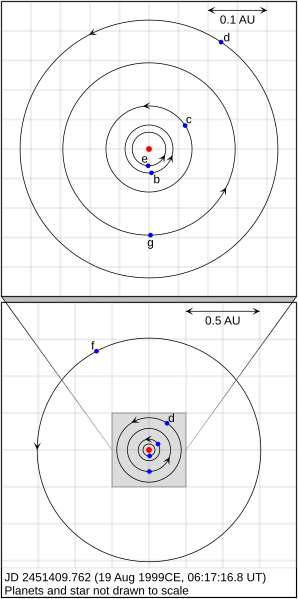File:GJ581orbits Vogt2010.svg

Original file (SVG file, nominally 707 × 1,421 pixels, file size: 10 KB)
Captions
Captions
Summary[edit]
| DescriptionGJ581orbits Vogt2010.svg |
English: Summary
SVG image of the Gliese 581 system orbits. Plot of the orbits of the Gliese 581 system, including the unconfirmed planet g. Orbit data taken from Vogt et al. (2010), "The Lick-Carnegie Exoplanet Survey: A 3.1 M⊕ Planet in the Habitable Zone of the Nearby M3V Star Gliese 581" The configuration is given in Table 2. The 6-planet solution quoted is for circular orbits, thus eccentricities are not represented. Assumptions:
Interpreting the diagram The planetary orbits are drawn in orthographic projection, as viewed from directly above the plane of the system so that the orbital direction is anticlockwise. The position of each planet in its orbit is given for the specified epoch, given in the Vogt et al. (2010) paper. While the orbits are drawn to the correct scale, the star and the planets themselves are not shown to scale as they would be too small to see on the scale of this diagram. In addition, the true radii of the planets themselves are currently unknown as no direct observation of the planets has yet been made. |
| Date | |
| Source | Own work |
| Author | Icalanise |
| Other versions |
|
Licensing[edit]
| Public domainPublic domainfalsefalse |
| I, the copyright holder of this work, release this work into the public domain. This applies worldwide. In some countries this may not be legally possible; if so: I grant anyone the right to use this work for any purpose, without any conditions, unless such conditions are required by law. |
File history
Click on a date/time to view the file as it appeared at that time.
| Date/Time | Thumbnail | Dimensions | User | Comment | |
|---|---|---|---|---|---|
| current | 13:19, 13 November 2010 |  | 707 × 1,421 (10 KB) | Icalanise (talk | contribs) | Minor layout tweaks |
| 13:50, 6 November 2010 |  | 640 × 1,312 (10 KB) | Icalanise (talk | contribs) | Separated inner and outer system diagrams to incorporate orbit of planet f, added direction arrows and metadata. | |
| 21:41, 12 October 2010 |  | 640 × 768 (3 KB) | Icalanise (talk | contribs) | Orbital diagram of the innermost five planets in the Vogt et al. (2010) six-planets solution for Gliese 581. |
You cannot overwrite this file.
File usage on Commons
The following 2 pages use this file:
File usage on other wikis
The following other wikis use this file:
- Usage on cs.wikipedia.org
- Usage on en.wikipedia.org
- Usage on es.wikipedia.org
- Usage on fa.wikipedia.org
- Usage on fi.wikipedia.org
- Usage on hr.wikipedia.org
- Usage on ja.wikipedia.org
- Usage on ko.wikipedia.org
- Usage on pt.wikipedia.org
- Usage on sv.wikipedia.org
- Usage on uk.wikipedia.org
- Usage on vi.wikipedia.org
- Usage on zh.wikipedia.org
Metadata
This file contains additional information such as Exif metadata which may have been added by the digital camera, scanner, or software program used to create or digitize it. If the file has been modified from its original state, some details such as the timestamp may not fully reflect those of the original file. The timestamp is only as accurate as the clock in the camera, and it may be completely wrong.
| Short title | Orbits of the Gliese 581 system (6-planet solution) |
|---|
